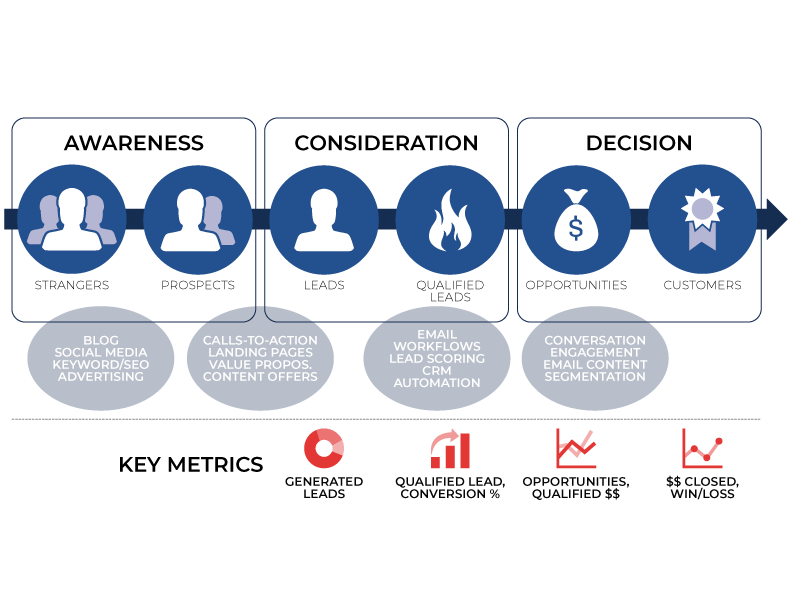Enabling the Next Generation of Business Growth.
Growth Blog.
The Road to Better Conversion Rates.
There is a lot of attention paid to marketing and sales metrics in an effort to improve process, close ratios and to grow revenues. Customer experience has emerged as a key to purchase decisions and price paid.
To have the best and most effective marketing and sales effort, and to deliver the best customer experience, having the right and integrated metrics in place is paramount.
It’s typical to measure the two “bookends” of the processes by measuring marketing’s inbound opens and clicks, and tracking deals closed in sales. But, there is a lot more going on in between these two ends of the marketing and sales process—each requiring attention, management and optimization. See the diagram below.
To optimize and maximize marketing and sales process and impact, it is important for the business to view this as an integrated effort. By this to bring together the marketing and sales metrics into a complete “cradle to grave” view of a contact through to customer.
Marketing Metrics —
For marketers it isn’t good enough to view success through the lenses of deliverable, opens and clicks. Marketing’s job isn’t over until the contact is either scored to a “nurture” category or becomes a customer. Pay attention and measure:
1. Inbound response rates. Go beyond simple open and click rates to measure and understand the rate of social media repost, social media handle and tag usage and online advertising conversions.
2. Call to action rates. First, if your outbound marketing doesn’t contain a clear and compelling call to action… stop and ensure that this is done from now on. Assuming your marketing contains great call-to-actions, be sure to measure inbound response, landing page navigation and second response, favored offer rates and submitted information for further follow up.
3. Marketing workflow and scoring. Often we can think that scoring is a sales-only exercise. It’s not. Marketing must undertake and complete it’s own contact and lead scoring efforts and cross-connect the results to contact lists, targeting, marketing campaign activities, call-to-actions and the unique characteristics of those that consistently score high. This information contributes significantly to improving targeting, messaging, offers, call-to-actions and communication vehicles, driving more qualified opportunity.
4. Segmentation. It’s common for marketers to segment their contact and customer lists, usually by industry, role or title, company size, location, etc. While it’s good to segment, these are the wrong segments to monitor and measure. Instead try segmenting by known pain points, company stage and culture, target work history (technical, business, operations, …) and many others. Basically, targeting based more on perception, and purchase characteristic factors.
Sales Metrics —
For sales leaders there are four metrics that contain key information to improve the probability of closing more deals, more often and for more money. If you’re not measuring and using these metrics for improvement consider how you can:
A. Generated leads quality. This requires a commonly understood and implemented contact scoring mechanism or model. While marketing may boast of how many opens, clicks and inbound requests generated, unless those efforts bring possible buyers it falls short.
B. Qualified opportunity conversion. This also requires a scoring method or tool that is universally applied to measure the quality of a particular prospect. It’s important to not only score each prospect but to also track and manage conversion ratios with an eye toward lowering the number of unqualified contacts and increasing the number of well qualified leads.
C. Qualified Opportunities. Again, a common scoring model or method drives this metric data. Of those that have been scored as qualified prospects/leads, what is the conversion to discovery of qualified opportunity for pursuit? This is where the salespeople must spend their time—pursuing qualified opportunity—instead of chasing unqualified leads or contacts.
D. Closed deals. Here attention is paid to deal size, profitability, connection back to marketing efforts and further understanding of “why the prospect bought” characteristics. Just because the deal was signed, and purchase made, doesn’t mean that the data gathering and process improvement is over.
E. Win/loss ratios. A critical metric of sales team effectiveness, but often overlooked. Sales teams tend to focus on “wins,” seeking more “wins’ and putting any “losses” behind. Big mistake. Following up with prospects that didn’t choose you returns key information to drive fast, effective improvement in marketing and selling.
One more thing —
Best practices indicate that leaders not only measure everything above, but also have integrated them all together to see the entire marketing and sales “value chain” performance. Using the information to improve process, allocate budgets better, grow decision accuracy and substantially increase predictable revenue achievement.
As you integrate these measurements, add one more dimension beyond ratios. Add the element of time by measuring the speed at which a contact moves through to becoming a customer. Measure the velocity of your marketing and sales efforts to improve the speed at which opportunity comes and moves through your sales process to become revenue.
The Afterburner Group has been identifying, operationalizing and integrating marketing and sales metrics for companies in the technology, energy, services, manufacturing and non-profit industries for over 25 years.
If you think that your marketing and sales process and metrics are suffering and could benefit from an assessment, improvement and impact, fill out the contact form below and we can explore what that might look like and how you’d benefit
© Afterburner.Group. All rights reserved.
Contact Afterburner.Group
Why consider us?
We are the leader in connecting complex, technology and engineered products, services, companies and brands to sustainable profitable demand.
If you're looking for growth, let's make it happen.
See things differently to create new opportunity and grow business value.
